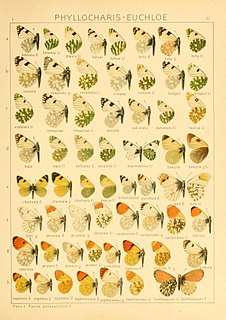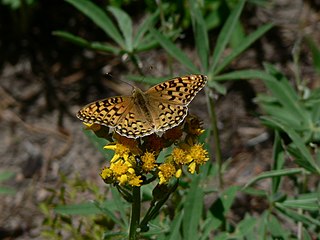
The Pieridae are a large family of butterflies with about 76 genera containing about 1,100 species, mostly from tropical Africa and tropical Asia with some varieties in the more northern regions of North America. Most pierid butterflies are white, yellow, or orange in coloration, often with black spots. The pigments that give the distinct coloring to these butterflies are derived from waste products in the body and are a characteristic of this family. The family was created by William John Swainson in 1820.

The red underwing is a moth of the family Erebidae. The species was first described by Carl Linnaeus in his 1767 12th edition of Systema Naturae.

Anthocharis cardamines, the orange tip, is a butterfly in the family Pieridae, which contains 1100 species of butterfly. A. cardamines is mainly found throughout Europe and temperate Asia (Palearctic) The males feature wings with a signature orange pigmentation, which is the origin of A. cardamines' common name.

Anthocharis belia, the Moroccan orange tip, is a butterfly of the family Pieridae. It is found in northwestern Africa. The length of the forewings is 18–20 millimetres (0.7–0.8 in).

Anthocharis midea, the falcate orangetip, is a North American butterfly that was described in 1809 by Jacob Hübner. It belongs to the family Pieridae, which is the white and sulphurs. These butterflies are mostly seen in the eastern United States, and in Texas and Oklahoma. They eat the nectar of violets and mustards. They tend to live in open, wet woods along waterways, in open swamps, and less often in dry woods and ridgetops. This species is a true springtime butterfly, being on the wing from April to May.

Anthocharis cethura, the desert orangetip or Felder's orangetip, is a species of butterfly in the subfamily Pierinae. It is native to the southwestern United States and northern Mexico, where it lives on hills and ridges in rocky desert habitat.

Anthocharis bambusarum is a butterfly which has a range of mainly in China and Eastern Asia. It has no known subspecies.

Anthocharis bieti is a butterfly which has a range that is confined to China. Subspecies A. b. tsangpoana was described from Tsangpo, Tibet.

The Pierinae are a large subfamily of pierid butterflies. The subfamily is one of several clades of butterflies often referred to as the whites. It includes the following species :

Speyeria zerene, the zerene fritillary, is a species of butterfly found in the western portions of the United States and Canada.

The tribe Anthocharini is one of the subdivisions of the insect order Lepidoptera, which includes the moths and butterflies. It is a further subdivision of the butterfly family Pieridae and subfamily Pierinae; formerly it was considered a subfamily on its own, Anthocharinae. This tribe includes many, but not all, of the orangetip butterflies.

The Indian fritillary is a species of butterfly of the nymphalid or brush-footed family. It is usually found from south and southeast Asia to Australia.

Glaucopsyche, commonly called blues, is a Nearctic genus of butterfly in the family Lycaenidae, found mainly in Palearctic Asia. For other species called "blues" see subfamily Polyommatinae and genus Plebejus.

Ochlodes sylvanoides, the woodland skipper, is a butterfly of the family Hesperiidae. It is found in North America from British Columbia south to southern California, east to Montana, Colorado and Arizona.
Orange tip or orangetip refers to:

Satyrium saepium, the hedgerow hairstreak, is a butterfly of the family Lycaenidae. It is found in western North America, from British Columbia south through California into Baja California and east through northern Arizona to northern New Mexico, Colorado and Montana.
















